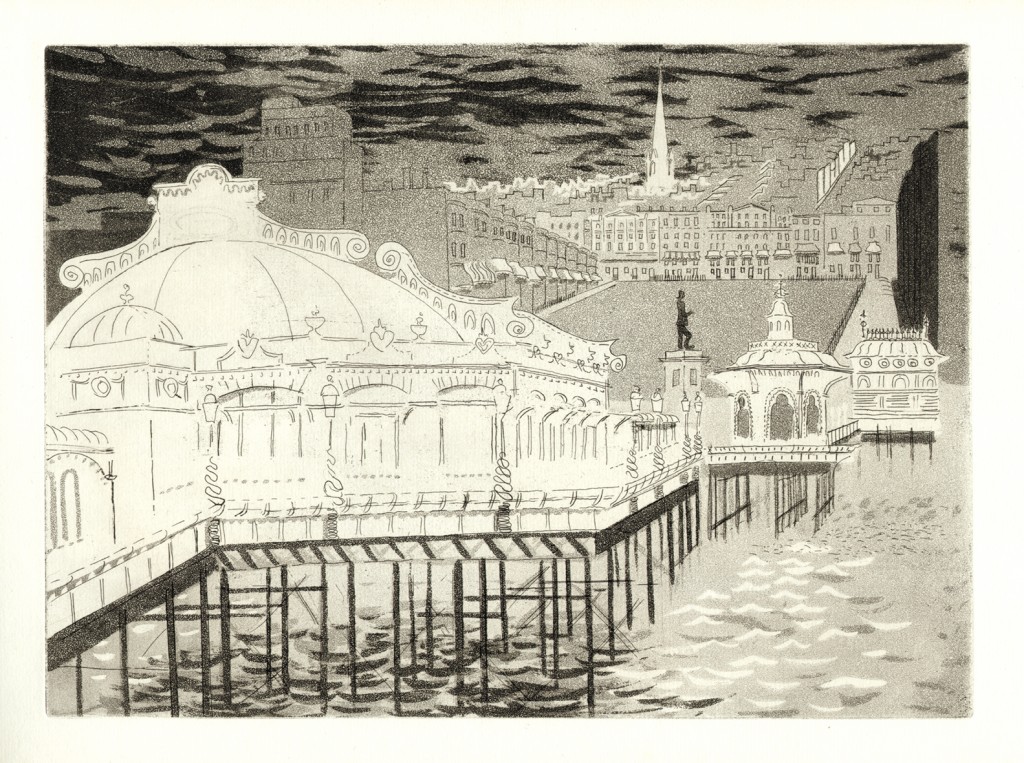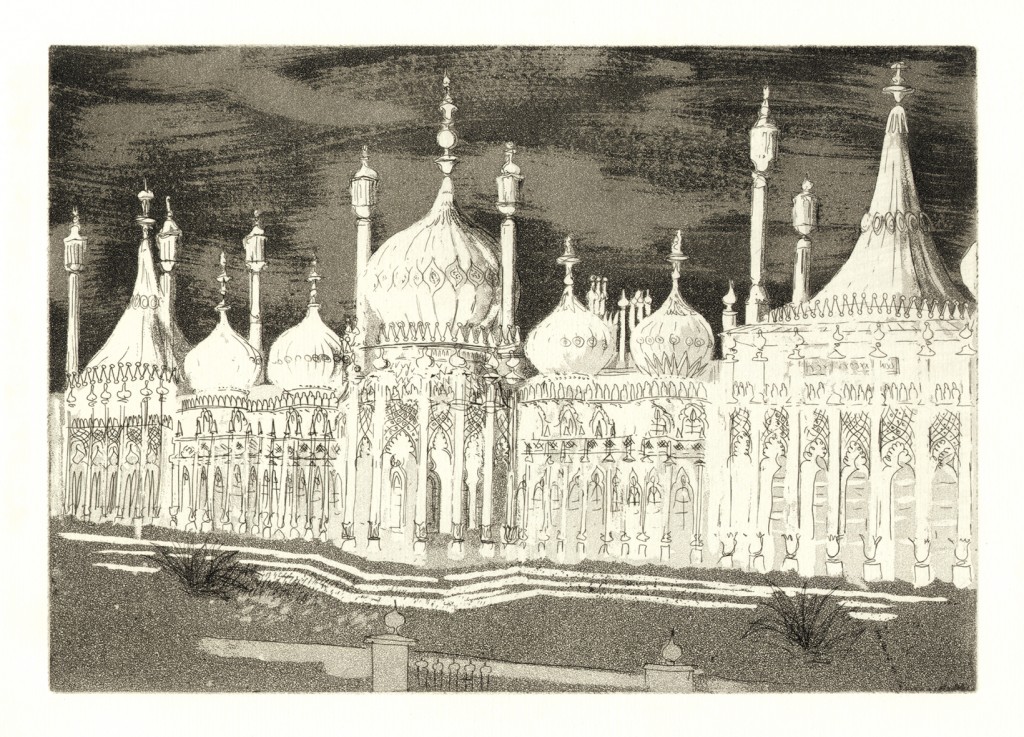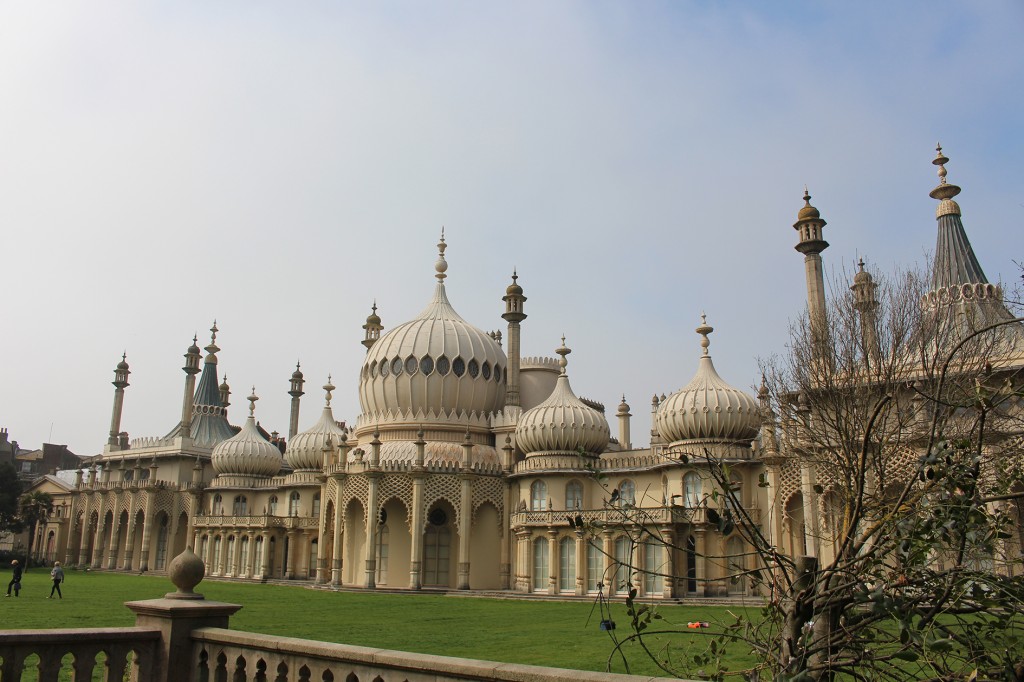
John Piper was one of the leading artists of the 20th century Modern British Art Movement. He worked in the abstract, romantic and classical traditions as a painter, ceramicist, writer, designer and printmaker. Piper’s 1939 illustrations for the book ‘Brighton Aquatints’, have been credited with the revival of the aquatint as a 20th century print medium in Britain.
The book consist of twelve aquatints of Brighton. Two hundred standard copies were printed and a further fifty-five copies were hand-coloured by the artist. The prints were not signed, although Piper did sign and dedicate some copies of the book. The illustrations were printed by the two Alexander brothers who had a basement workshop in Henrietta Street, Covent Garden, London. The watermarks which appear in the paper are irregularly placed and are styled as a hand raised in blessing, a head, said to be that of Christ, and the date 1399.
The process of creating an aquatint involves exposing a plate, usually of copper or zinc, to acid through an applied layer of granulated, melted resin. The acid incises the plate between the granules creating areas of evenly pitted surface. This can be varied by applying additional resin, scraping and burnishing. Different strengths of acids are also employed. When the grains are removed and the plate is printed it results in variations of tone. The effect often resembles watercolours and wash drawings, hence the name Aquatint.
Rooted in the English tradition John Piper’s work often relates to a place, be that a landscape or a building. Piper brings a particular quality of engagement to his subjects. He captures the poetic, his emotional response and thoughts, as well as the essence of the physical reality. These themes and responses belong to the English Romantic tradition. Piper seeks to look beyond what is immediately apparent; to what the artist Paul Nash referred to as the ‘genius loci’, the spirit of the place, ‘a reality more real’.

John Piper’s ‘Brighton Aquatints’ combine technical innovation with exceptional draughtsmanship, complexity and detail. They are accompanied by a very personal introduction by Lord Alfred Douglas and notes to each image by the artist.
This ‘Piperesque’ view of Brighton re-acquaints us with the familiar. I was in Brighton last week as a sea fret rolled in causing the Brighton Pavilion to shimmer in the bright spring sunlight. The scene was reminiscent of Piper’s view of the ‘The Royal Pavilion’ which remains remarkably unchanged from his 1939 aquatint. In his notes Piper describes the building’s extravagant beauty and the great affection in which it is held.

In ‘Regency Square from the West Pier’ we are reminded of a view now lost to us. John Piper describes how the pier appears like a ‘dazzling white meringue, brittle and sweet…florid and grand as anywhere.’ Regency Square is laid out on a gentle slope in the view beyond.
In both these aquatint prints the use of acid at different stages in the process has created the texture of the grass and background. Stopping out varnish repeatedly applied has been used to create the waves and skies.
John Piper wrote quoting Constable ‘Painting is with me but another word for feeling…’ Piper’s ability to use landscapes and buildings as a focus for his emotions has the effect of gifting the world with, what has been described as, ‘a human sensibility’. These qualities are apparent in ‘Brighton Aquatints’. His work gives an extraordinary articulation of the English vision and spirit.
John Piper’s ‘Brighton Aquatints’ rarely comes to the market and so it is with some excitement that I am looking forward to Toovey’s specialist Book sale on Tuesday 21st April, in which a copy, signed by the artist, will be auctioned with a pre-sale estimate of £2000-3000. (View the lot here)
By Revd. Rupert Toovey. Originally published on 15th April 2015 in the West Sussex Gazette.